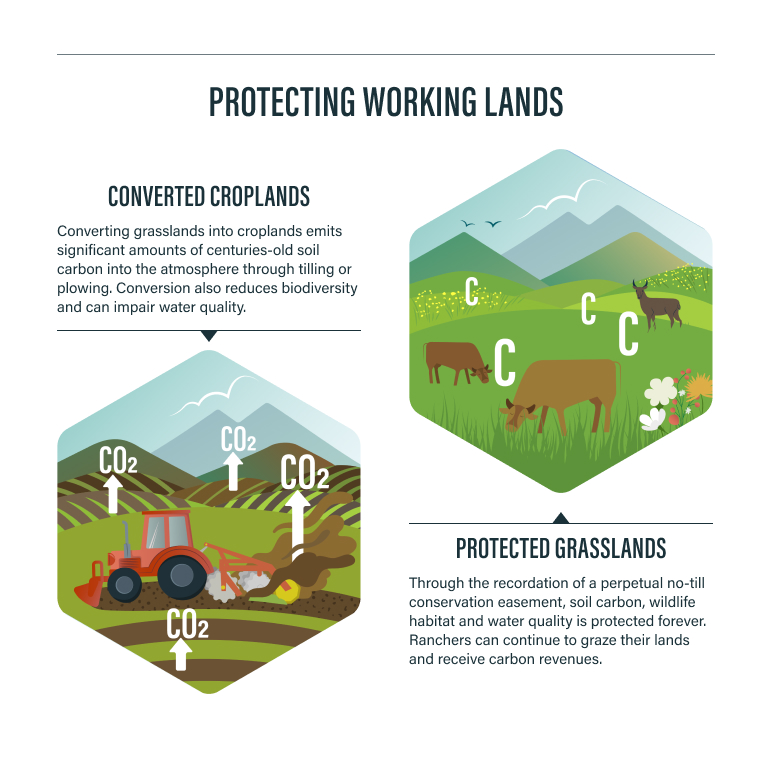Grasslands
The Climate Trust supports working ranches and rural communities as the country’s only source of carbon funding for grassland conservation.
Grasslands are the least protected ecosystem in the United States. A World Wildlife Fund report shows that nearly 1.9 million acres of grasslands were destroyed across the U.S. and Canadian Great Plains in 2022 alone. As climate change models predict drier conditions across much of the American West, carbon projects help protect critical prairie habitats and ranching livelihoods by creating conservation agreements and an additional revenue stream for family ranches.
The Climate Trust aims to increase access to the carbon markets for family-owned and operated ranches, which historically have not been able to easily access the markets because of high technical barriers and the relatively small size of holdings. By breaking down these barriers, we can expand the protection of working lands and ranches.
Project Development Process


The Climate Trust works directly with landowners to determine their eligibility, record a conservation easement with their land trust, model GHG emissions, develop a project and conduct ongoing monitoring of the land, manage third-party verification, and conduct marketing and sales of resulting carbon credits.
What are grassland carbon projects?
When grasslands are tilled to be converted and maintained as croplands, significant amounts of soil carbon emissions are released into the atmosphere. By placing grasslands under perpetual conservation easements, landowners agree to protect their grassland soils forever. While this means that land is protected from future development and conversion, ranchers can still graze their cattle and continue to run daily operations in the same way. Beyond protecting soil carbon and ranching livelihoods, these projects build landscape-level climate resiliency for one of the most biodiverse ecosystems in the world.

Why Work with us?
We get our hands dirty working alongside landowners from the very first site visit. First, we determine carbon project feasibility, meet with ranchers on their land, and work to ensure easement and project compatibility. From there, we conduct carbon modeling and develop all required documentation to monitor, report, and verify carbon impact throughout the carbon registry term. Once offsets are issued, The Climate Trust sells them on behalf of landowners and provides that revenue back to them on an ongoing basis.
The Climate Trust is the leading developer of carbon projects for grasslands. We helped write the Climate Action Reserve Grassland Protocol in 2015, the American Carbon Registry’s Avoided Conversion of Grasslands Methodology in 2013, transacted the first-ever American Carbon Registry grassland conservation offsets in 2014, made some of the earliest investments into grassland conservation easements, and formed the first rancher carbon cooperatives in the country. As a nonprofit, we are always looking for innovative ways to deepen our impact. We have been the recipient of multiple USDA Conservation Innovation Grants and partnered with the Land Trust Alliance in 2020 to help scale carbon-based investments in grassland conservation for small landowners.
COMMON TERMS
- Conservation Easement: a perpetual restriction that prohibits the conversion of grassland into cropland. This is recorded on the property deed and runs with the land, no matter the owner.
- Carbon Offset: the storage or avoided emission of one metric ton of carbon dioxide (the atmospheric equivalent) after applying transparent, science-based carbon accounting and passing third-party verification.
- Co-benefits: positive impacts on the ecosystems, biodiversity, wildlife, and community surrounding a carbon project.
- Additionality: the reduction or removal of carbon emissions resulting from a carbon project compared to a baseline. In the case of grasslands, the perpetual avoidance of soil carbon emissions that would have occurred as a result of conversion to cropland.
- Third-party Verification: the verification of a project’s eligibility, measurements, and modeling through an ANSI-accredited verification body or auditor.